Changes of γ-Aminobutyric Acid, Phytoestrogens, and Biofunctional Properties of the Isoflavone-Enriched Soybean (Glycine max) Leaves during Solid Lactic Acid Fermentation
Abstract
1. Introduction
2. Materials and Methods
2.1. Preparation of IESLs and Starters
2.2. Culture Medium and Chemical Regents
2.3. Solid Lactic Acid Fermentation of IESLs
2.4. Determination of pH, Acidity, and Viable Cell Numbers
2.5. Determination of Enzymatic Activity
2.6. Determination of GA and GABA
2.7. Preparation of Extracts
2.8. Determination of TP and TF Contents
2.9. Determination of Isoflavones
2.10. Determination of Antioxidant Activities
2.11. Determination of Enzyme Inhibitory Effects
2.12. Statistical Analysis
3. Results
3.1. pH, Acidity, Viable Cell Numbers, and Enzyme Activities during Fermentation
3.2. Measurement of GA and GABA Contents during the Fermentation of IESLs
3.3. Enhancement of TP and TF Contents during the Fermentation of IESLs
3.4. Changes in Isoflavone Contents during the Fermentation of IESLs
3.5. Increased Antioxidant Activity in the Fermented IESLs
3.6. Changes in Enzymatic Inhibitory Activity during the Fermentation of IESLs
4. Discussion
5. Conclusions
Author Contributions
Funding
Institutional Review Board Statement
Informed Consent Statement
Data Availability Statement
Conflicts of Interest
References
- Wang, H.J.; Muphy, P.A. Isoflavone content in commercial soybean foods. J. Agric. Food Chem. 1994, 42, 1666–1673. [Google Scholar] [CrossRef]
- Ban, Y.J.; Song, Y.H.; Kim, J.Y.; Baiseitova, A.; Lee, K.W.; Kim, K.D.; Park, K.H. Comparative investigation on metabolites changes in soybean leaves by ethylene and activation of collagen synthesis. Ind. Crops Prod. 2020, 154, 112743. [Google Scholar] [CrossRef]
- Yuk, H.J.; Song, Y.H.; Curtis-Long, M.J.; Kim, D.W.; Woo, S.G.; Lee, Y.B.; Uddin, Z.; Kim, C.Y.; Park, K.H. Ethylene induced a high accumulation of dietary isoflavones and expression of isoflavonoid biosynthetic genes in soybean (Glycine max) leaves. J. Agric. Food Chem. 2016, 64, 7315–7324. [Google Scholar] [CrossRef]
- Yoon, J.A.; Kwun, S.Y.; Park, E.H.; Kim, M.D. Changes in isoflavone contents and physicochemical properties of soybean leaf extract by extraction conditions. Microbiol. Biotechnol. Lett. 2019, 47, 64–68. [Google Scholar] [CrossRef]
- Kwun, S.Y.; Yoon, J.A.; Park, E.H.; Kim, M.D. Improving the aglycon isoflavone content in soybean leaf extracts by lactic acid fermentation. J. Agri. Life Environ. Sci. 2019, 31, 160–170. [Google Scholar]
- Lee, J.H.; Hwang, C.E.; Cho, E.J.; Song, Y.H.; Kim, S.C.; Cho, K.M. Improvement of nutritional components and in vitro antioxidative properties of soy-powder yogurts using Lactobacillus plantarum. J. Food Drug Anal. 2018, 26, 1054–1065. [Google Scholar] [CrossRef]
- Lee, J.H.; Kim, B.; Hwang, C.E.; Haque, M.A.; Kim, S.C.; Lee, C.S.; Kang, S.S.; Cho, K.M.; Lee, D.H. Changes in conjugated linoleic acid and isoflavone contents from fermented soymilks using Lactobacillus plantarum P1201 and screening for their digestive enzyme inhibition and antioxidant properties. J. Funct. Foods 2018, 43, 17–28. [Google Scholar] [CrossRef]
- Lee, J.H.; Hwang, C.E.; Son, K.S.; Cho, K.M. Comparisons of nutritional constituents in soybeans during solid state fermentation times and screening for their glucosidase enzymes and antioxidant properties. Food Chem. 2019, 272, 362–371. [Google Scholar] [CrossRef] [PubMed]
- Hwang, C.E.; Kim, S.C.; Kim, D.H.; Lee, H.Y.; Shu, H.K.; Cho, K.M.; Lee, J.H. Enhancement of isoflavone aglycone, amino acid, and CLA contents in fermented soybean yogurts using different strains: Screening of antioxidant and digestive enzyme inhibition properties. Food Chem. 2021, 340, 128199. [Google Scholar] [CrossRef] [PubMed]
- Kim, M.-S.; Jun, Y.S.; Jang, D.; Cho, C.H.; Lee, S.-H.; Han, N.S.; Kim, D.-O. Antioxidant capacity of 12 major soybean isoflavones and their bioavailability under simulated digestion and in human intestinal Caco-2 cells. Food Chem. 2022, 374, 131493. [Google Scholar] [CrossRef] [PubMed]
- Liang, Y.S.; Qi, W.T.; Guo, W.; Wang, C.L.; Hu, Z.B.; Li, A.K. Genistein and daidzein induce apoptosis of colon cancer cells by inhibiting the accumulation of lipid droplets. Food Nutr. Res. 2018, 62, 1384. [Google Scholar] [CrossRef]
- Takaoka, O.; Mori, T.; Ito, F.; Okimura, H.; Kataoka, H.; Tanaka, Y.; Koshiba, A.; Kusuki, I.; Shigehiro, S.; Amami, T.; et al. Daidzein-rich isoflavone aglycones inhibit cell growth and inflammation in endometriosis. J. Steroid Biochem. Mol. Biol. 2018, 181, 125–132. [Google Scholar] [CrossRef]
- Zhou, L.; Xiao, X.; Zhang, Q.; Zheng, J.; Li, M.; Yu, M.; Wang, X.; Deng, M.; Zhai, X.; Li, R.; et al. Dietary genistein could modulate hypothalamic circadian entrainment, reduce body weight, and improve glucose and lipid metabolism in female mice. Int. J. Endocrinol. 2019, 2019, 2163838. [Google Scholar] [CrossRef]
- Chen, P.; Sun, J.; Liang, Z.; Xu, H.; Du, P.; Li, A.; Meng, Y.; Reshetnik, E.I.; Liu, L.; Li, C. The bioavailability of soy isoflavones in vitro and their effects on gut microbiota in the simulator of the human intestinal microbial ecosystem. Food Res. Int. 2022, 152, 110868. [Google Scholar] [CrossRef] [PubMed]
- Choi, J.H.; Lee, S.B. High production of GABA in Pyrus usuriensis Maximowicz fruit extract by mixed fermentation of lactic acid bacteria. Koran J. Food Preserv. 2019, 26, 642–649. [Google Scholar] [CrossRef]
- Hwang, C.E.; Kim, S.C.; Lee, J.H.; Hong, S.Y.; Cho, K.M. Enhanced biological effect of fermented soy-powder milk with Lactobacillus brevis increasing in γ-aminobutyric acid and isoflavone aglycone contents. J. Appl. Biol. Chem. 2018, 61, 245–255. [Google Scholar] [CrossRef]
- Nikmaram, N.; Dar, B.N.; Roohinejad, S.; Koubaa, M.; Barba, F.J.; Greiner, R.; Johnson, S.K. Recent advances in γ-aminobutyric acid (GABA) properties in pulses: An overview. J. Sci. Food Agric. 2017, 97, 2681–2689. [Google Scholar] [CrossRef]
- Smart, T.G.; Stephenson, F.A. A half century of γ-aminobutyric acid. Brain Neurosci. Adv. 2019, 3, 2398212819858249. [Google Scholar] [CrossRef]
- Cataldo, P.G.; Villegas, J.M.; de Giori, G.S.; Saavedra, L.; Hebert, E.M. Enhancement of γ-aminobutyric acid (GABA) production by Lactobacillus brevis CRL 2013 based on carbohydrate fermentation. Int. J. Food Microbiol. 2020, 333, 108792. [Google Scholar] [CrossRef]
- Hwang, C.E.; Haque, M.A.; Lee, J.H.; Joo, O.S.; Kim, S.C.; Lee, H.Y.; Um, B.S.; Park, K.S.; Cho, K.M. Comparison of γ-aminobutyric acid and isoflavone aglycone contents, to radical scavenging activities of high-protein soybean sprouting by lactic acid fermentation with Lactobacillus brevis. Korean J. Food Preserv. 2018, 25, 7–18. [Google Scholar] [CrossRef]
- Hwang, C.E.; An, M.J.; Lee, H.Y.; Lee, B.W.; Kim, H.T.; Ko, J.M.; Baek, I.Y.; Seo, W.T.; Cho, K.M. Potential probiotic Lactobacillus plantarum P1201 to produce soy-yogurt with enhanced antioxidant activity. Korean J. Food Sci. Technol. 2014, 46, 556–565. [Google Scholar] [CrossRef][Green Version]
- Haque, M.A.; Ashik, M.A.; Aktar, S.; Akter, M.S.; Halilu, A.; Haque, M.A.; Islam, M.R.; Abdullah-Al-Mamun, M.; Nahar, M.N.; Das, S.R.; et al. Rapid deconstruction of cotton, coir, areca, and banana fibers recalcitrant structure using a bacterial consortium with enhanced saccharification. Waste Biomass Valorization 2021, 12, 4001–4018. [Google Scholar] [CrossRef]
- Das, S.R.; Haque, M.A.; Akbor, M.A.; Abdullah-Al-Mamun, M.; Debnath, G.C.; Hossain, M.S.; Hasan, Z.; Rahman, A.; Islam, M.A.; Hossain, M.A.; et al. Organophosphorus insecticides mineralizing endophytic and rhizospheric soil bacterial consortium influence eggplant growth promotion. Arch. Microbiol. 2022, 204, 199. [Google Scholar] [CrossRef]
- Ham, S.; Bhatia, S.K.; Gurav, R.; Choi, Y.-K.; Jeon, J.-M.; Yoon, J.-J.; Choi, K.-Y.; Ahn, j.; Kim, H.T.; Yang, Y.-H. Gamma aminobutyric acid (GABA) production in Escherichia coli with pyridoxal kinase (pdxY) based regeneration system. Enzym. Microb. Technol. 2022, 155, 10994. [Google Scholar] [CrossRef]
- Sarasa, S.B.; Mahendran, R.; Muthusamy, G.; Thankappan, B.; Selta, D.R.F.; Angayarkanni, J. A brief review on the non-protein amino acid, gamma-amino butyric acid (GABA): Its production and role in microbes. Curr. Microbiol. 2019, 77, 534–544. [Google Scholar] [CrossRef]
- Diana, M.; Tres, A.; Quílez, J.; Llombart, M.; Rfecas, M. Spanish cheese screening and selection of lactic acid bacteria with high gamma-aminobutyric acid production. LWT 2014, 56, 351–355. [Google Scholar] [CrossRef]
- Streeter, J.G.; Thompson, J.F. In vivo and in vitro studies on γ-aminobutyric acid metabolism with the radish plant (Raphanus sativus, L.). Plant Physiol. 1972, 49, 579–584. [Google Scholar] [CrossRef][Green Version]
- Li, H.; Gao, D.; Cao, Y.; Xu, H. A high γ-aminobutyric acid producing Lactobacillus brevis isolated from Chinese traditional paocai. Ann. Microbiol. 2008, 58, 649–653. [Google Scholar] [CrossRef]
- Yang, S.Y.; Lu, F.X.; Lu, Z.X.; Bie, X.M.; Jiao, Y.; Sun, L.J.; Yu, B. Production of gamma-aminobutyric acid by Streptococcus salivarius subsp thermophilus Y2 under submerged fermentation. Amino Acids 2008, 34, 473–478. [Google Scholar] [CrossRef]
- Donkor, O.N.; Shah, N.P. Production of β-glucosidase and hydrolysis of isoflavone phytoestrogens by Lactobacillus acidophilus, Bifidobacterium lactis, and Lactobacillus casei in soymilk. J. Food Sci. 2008, 73, M15–M20. [Google Scholar] [CrossRef]
- Otieno, D.O.; Ashton, J.F.; Shah, N.E. Stability of β-glucosidase activity produced by Bifidobacterium and Lactobacillus spp. in fermented soymilk during processing and storage. J. Food Sci. 2005, 70, M236–M241. [Google Scholar] [CrossRef]
- Zhong, Y.; Wu, S.; Chen, F.; He, M.; Lin, J. Isolation of high γ-aminobutyric acid-producing lactic acid bacteria and fermentation in mulberry leaf powders. Exp. Ther. Med. 2019, 18, 147–153. [Google Scholar] [CrossRef]
- Han, M.; Liao, W.; Wu, S.; Gong, X.; Bai, C. Use of Streptococcus thermophilus for the in situ production of γ-aminobutyric acid-enriched fermented milk. J. Dairy Sci. 2020, 103, 98–105. [Google Scholar] [CrossRef] [PubMed]
- Moore, J.F.; Vivier, R.D.; Johanningsmeier, S.D. Formation of γ-aminobutyric acid (GABA) during natural lactic acid fermentation of cucumber. J. Food Comp. Anal. 2021, 96, 103711. [Google Scholar] [CrossRef]
- Park, K.B.; Oh, S.H. Production and characterization of GABA rice yogurt. Korean J. Food Sci. Technol. 2005, 14, 518–522. [Google Scholar]
- Kook, M.C.; Cho, S.C. Production of GABA (gamma amino butyric acid) by lactic acid bacteria. Korean J. Food Sci. Anim. Resour. 2013, 33, 377–389. [Google Scholar] [CrossRef]
- Oh, S.H.; Cha, Y.S. Regulation of γ-aminobutyric acid production in tobacco plants by expressing a mutant calmodulin gene. Agric. Chem. Biotechnol. 2000, 42, 69–73. [Google Scholar]
- Han, K.H.; Chung, H.Y. Quality characteristics of the fermented mulberry leaves. Food Eng. Prog. 2019, 23, 251–257. [Google Scholar] [CrossRef]
- Kim, Y.M.; Jeong, H.j.; Chung, H.S.; Seong, J.H.; Kim, H.S.; Kim, D.S.; Lee, Y.G. Anti-oxidative activity of the extracts from Houttuynia cordata Thunb. fermented by lactic acid bacteria. J. Life. Sci. 2016, 26, 468–474. [Google Scholar] [CrossRef][Green Version]
- Bae, D.B.; Kim, K.H.; Yook, H.S. Antioxidant and tyrosinase inhibitory activities of fermented Gynura procumbens. J. Korean Soc. Food Sci. Nutr. 2019, 48, 1214–1222. [Google Scholar] [CrossRef]
- Cho, K.M.; Cho, H.K.; Lee, J.Y.; Seo, W.T.; Kim, M.K. Quality characteristics and antioxidant effects during makgeolli fermentation by purple sweet potato-rice nuruk. Korean J. Food Sci. Technol. 2012, 44, 728–735. [Google Scholar] [CrossRef]
- Chien, H.L.; Huang, H.Y.; Chou, C.C. Transformation of isoflavone phytoestrogens during the fermentation of soymilk with lactic acid bacteria and bifidobacteria. Food Microbiol. 2006, 23, 772–778. [Google Scholar] [CrossRef] [PubMed]
- Hur, S.J.; Lee, S.Y.; Kim, Y.C.; Choi, I.; Kim, G.B. Effect of fermentation on the antioxidant activity in plant-based foods. Food Chem. 2014, 160, 346–356. [Google Scholar] [CrossRef]
- Park, G.; Park, J.Y.; Chang, Y.H. Changes in flavonoid aglycone contents and antioxidant activities of citrus peel depending on enzyme treatment times. J. Korean Soc. Food Sci. Nutr. 2019, 48, 542–550. [Google Scholar] [CrossRef]
- Rekha, C.R.; Vijayalakshmi, G. Bioconversion of isoflavone glycosides to aglycones, mineral bioavailability and vitamin B complex in fermented soymilk by probiotic bacteria and yeast. J. Appl. Microbiol. 2010, 109, 1198–1208. [Google Scholar] [CrossRef]
- Cho, E.K.; Cho, H.Y.; Kim, B.C.; Shin, H.H.; Cho, S.C.; Kook, M.C.; Pyun, Y.R. Development of Pretreatment and Mixed Culture Processes for Plant Originated Lactic Acid to Produce a Functional. Korean J. Food Nutr. 2011, 24, 117–123. [Google Scholar] [CrossRef][Green Version]
- Kim, J.H.; Hwang, C.E.; Lee, C.K.; Lee, J.H.; Kim, G.M.; Jeong, S.H.; Cho, K.M. Characteristics and antioxidant effect of garlic in the fermentation of Cheonggukjang by Bacillus amyloliquefaciens MJ1-4. J. Microbiol. Biotechnol. 2014, 24, 959–968. [Google Scholar] [CrossRef]
- Kim, G.D.; Lee, Y.S.; Cho, J.Y.; Lee, Y.H.; Choi, K.J.; Lee, Y.; Han, T.H.; Lee, S.H.; Park, K.H.; Moon, J.H. Comparison of the content of bioactive substances and the inhibitory effects against rat plasma oxidation of conventional and organic hot peppers (Capsicum annuum L.). J. Agric. Food Chem. 2010, 58, 12300–12306. [Google Scholar] [CrossRef]
- Myo, H.; Nantarat, N.; Khat-Udomkiri, N. Changes in bioactive compounds of coffee pulp though fermentation-based biotransformation using Lactobacillus plantarum TISTR 543 and its antioxidant activities. Fermentation 2021, 7, 292. [Google Scholar] [CrossRef]
- Jeong, E.J.; Kim, J.Y.; Moon, S.H.; Park, G.Y. Characteristics, antioxidative activities and growth inhibitory effects in AGS human gastric adenocarcinoma cells of soymilk fermented by Bacillus subtilis KC-3 during fermentation. J. Korean Soc. Food Sci. Nutr. 2010, 39, 1113–1118. [Google Scholar]
- Jin, Y.H.; Hong, J.H.; Lee, J.-H.; Yoon, H.; Pawluk, A.M.; Yun, S.J.; Mah, J.-H. Lactic acid fermented green tea with Levilactobacillus brevis capable of producing γ-aminobutyric acid. Fermentation 2021, 7, 110. [Google Scholar] [CrossRef]
- Chang, Y.; Fan, W.; Shi, H.; Feng, X.; Zhang, D.; Wang, L.; Zheng, Y.; Guo, L. Characterization of phenolics and discovery of α-glucosidase inhibitors in Artemisia argyi leaves based on ultra-performance liquid chromatography-tandem mass spectrometry and relevance analysis. J. Pharm. Biomed. Anal. 2022, 2020, 114982. [Google Scholar] [CrossRef] [PubMed]
- Balasubramaniam, V.; Mustar, S.; Khalid, N.M.; Rashed, A.A.; Noh, M.F.M.; Wilcox, M.D.; Chater, P.I.; Brownlee, I.A.; Pearson, J.P. Inhibitory activities of three Malaysian edible seaweeds on lipase and α-amylase. J. Appl. Phycol. 2013, 25, 1405–1412. [Google Scholar] [CrossRef]
- You, Q.; Chen, F.; Wang, X.; Jiang, Y.; Lin, S. Anti-diabetic activities of phenolic compounds in muscadine against α-glucosidase and pancreatic lipase. LWT 2012, 46, 164–168. [Google Scholar] [CrossRef]
- Stern, J.L.; Hagerman, A.E.; Steinberg, P.D.; Mason, P.K. Phlorotannins-protein interactions. J. Chem. Ecol. 1996, 22, 1877–1899. [Google Scholar] [CrossRef]
- Tan, Y.; Chang, S.K.C.; Zhang, Y. Comparison of α-amylase, α-glucosidase and lipase inhibitory activity of the phenolic substances in two black legumes of different genera. Food Chem. 2017, 214, 259–268. [Google Scholar] [CrossRef] [PubMed]
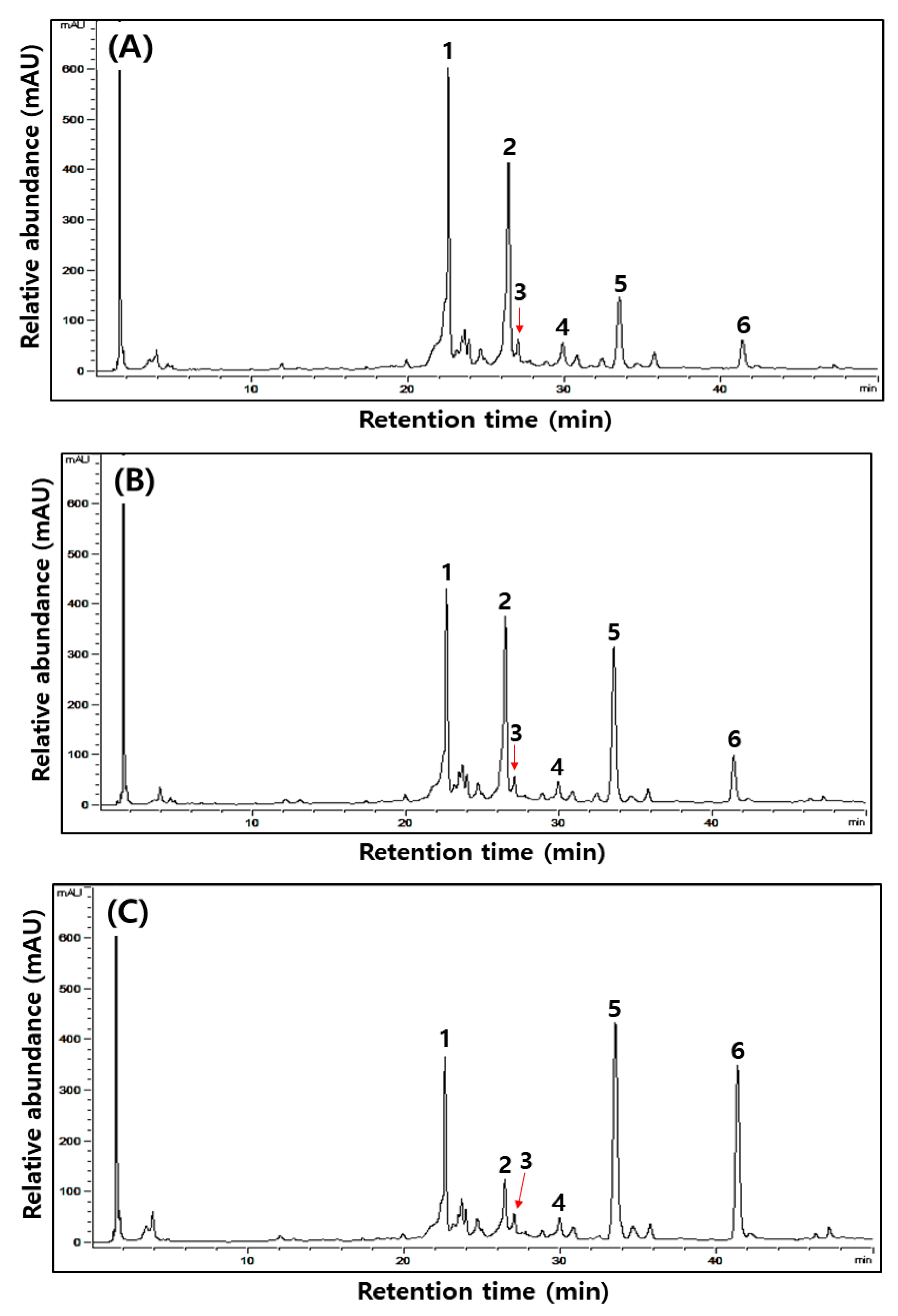
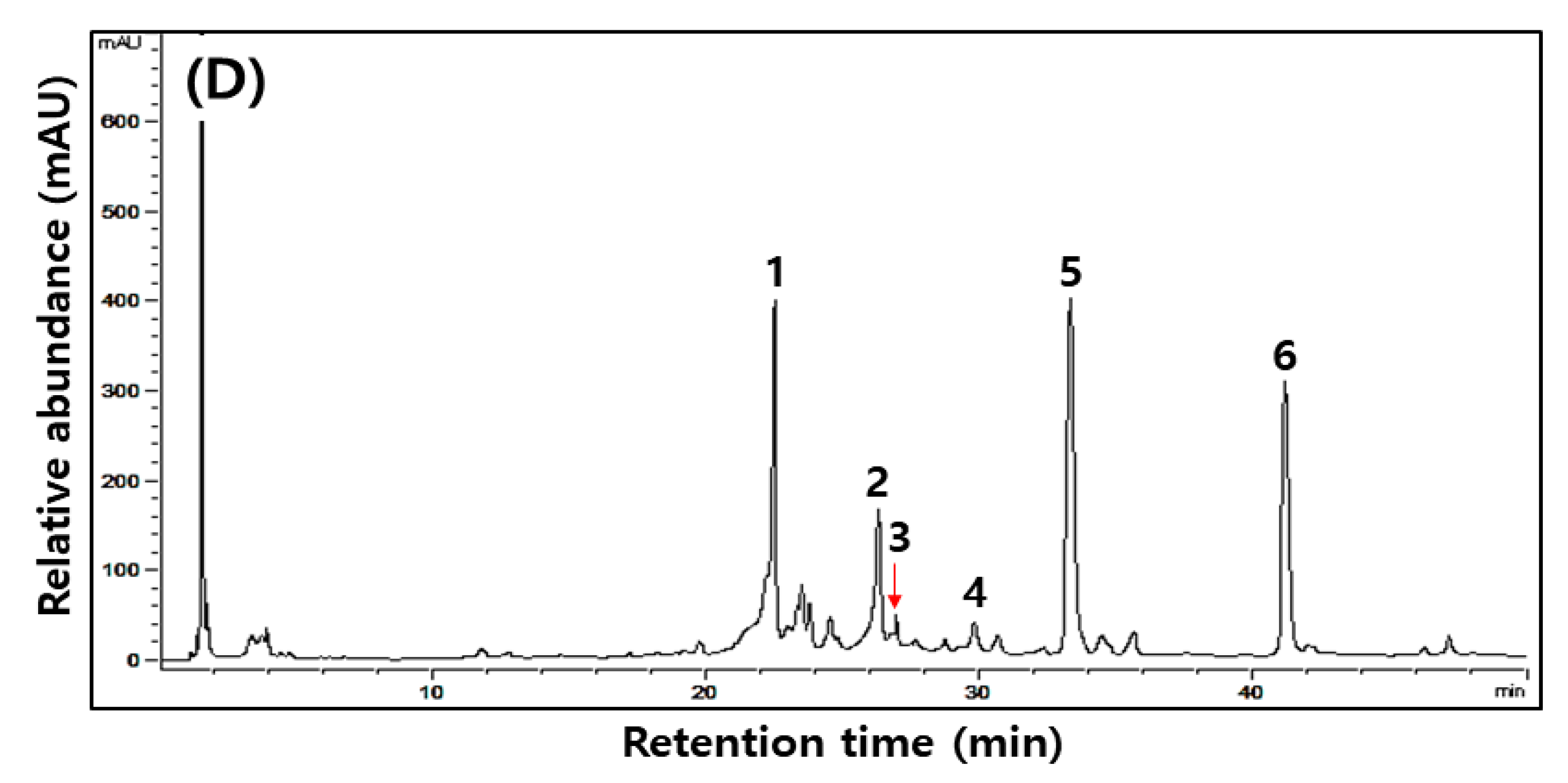
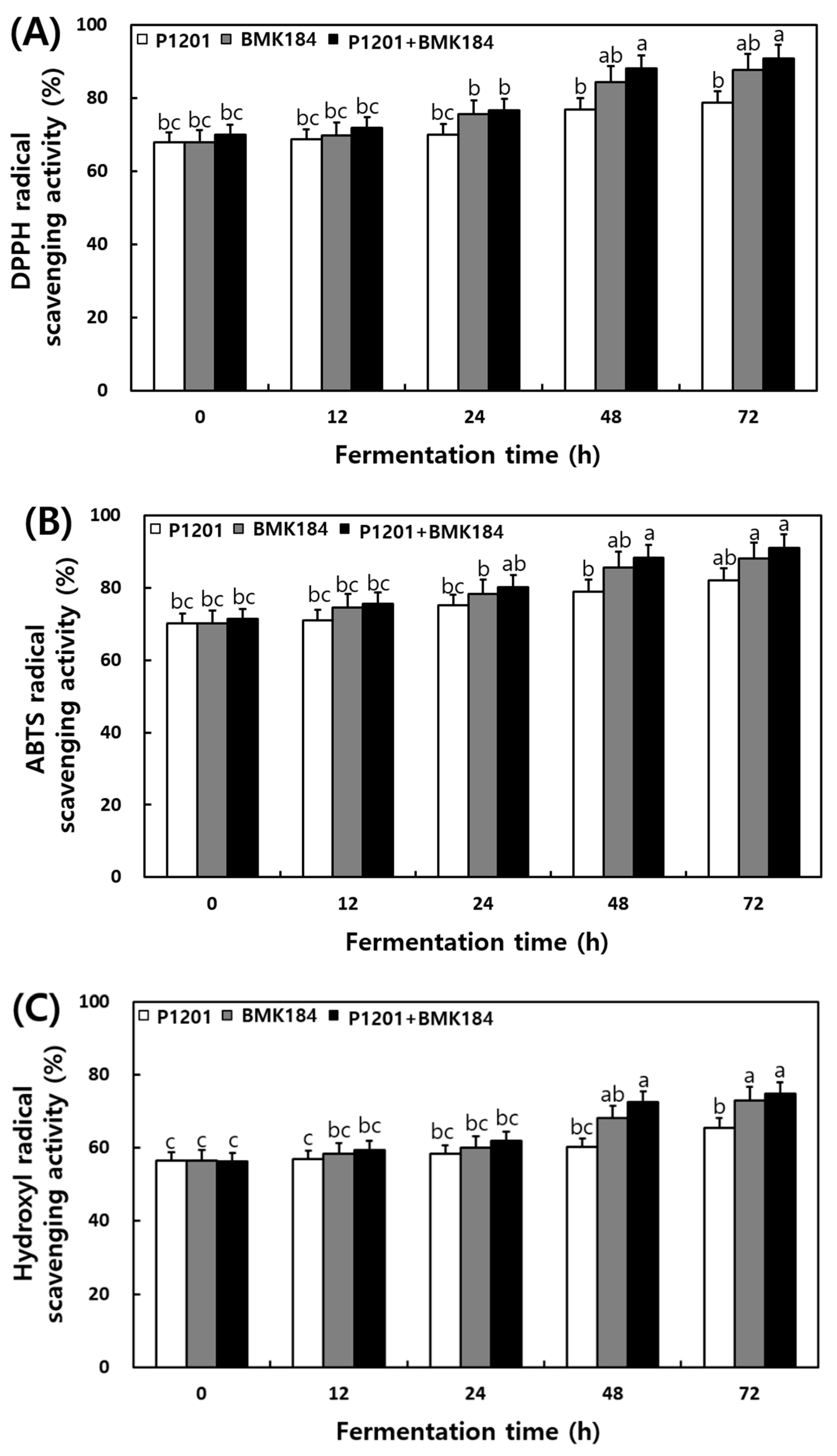

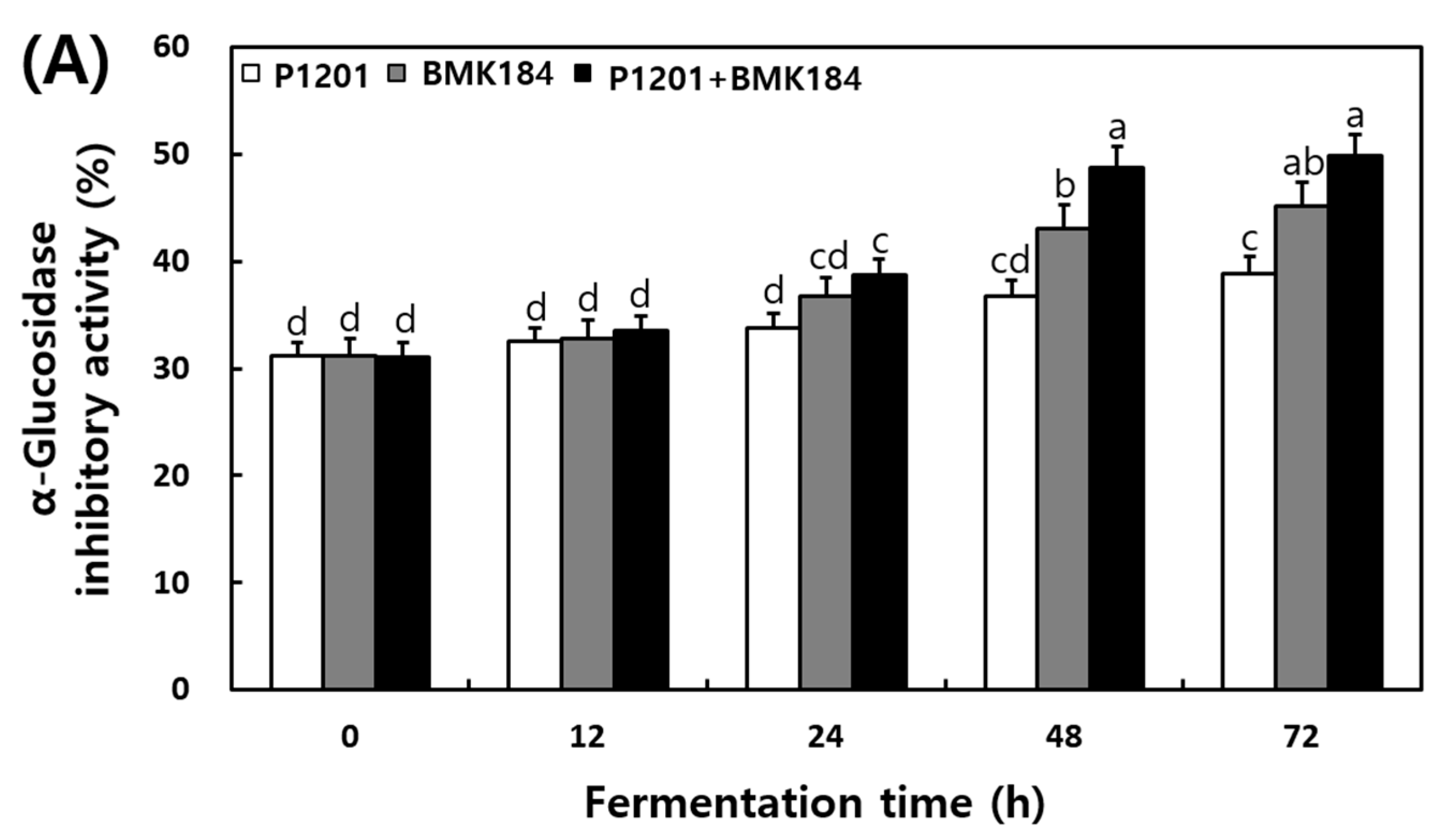
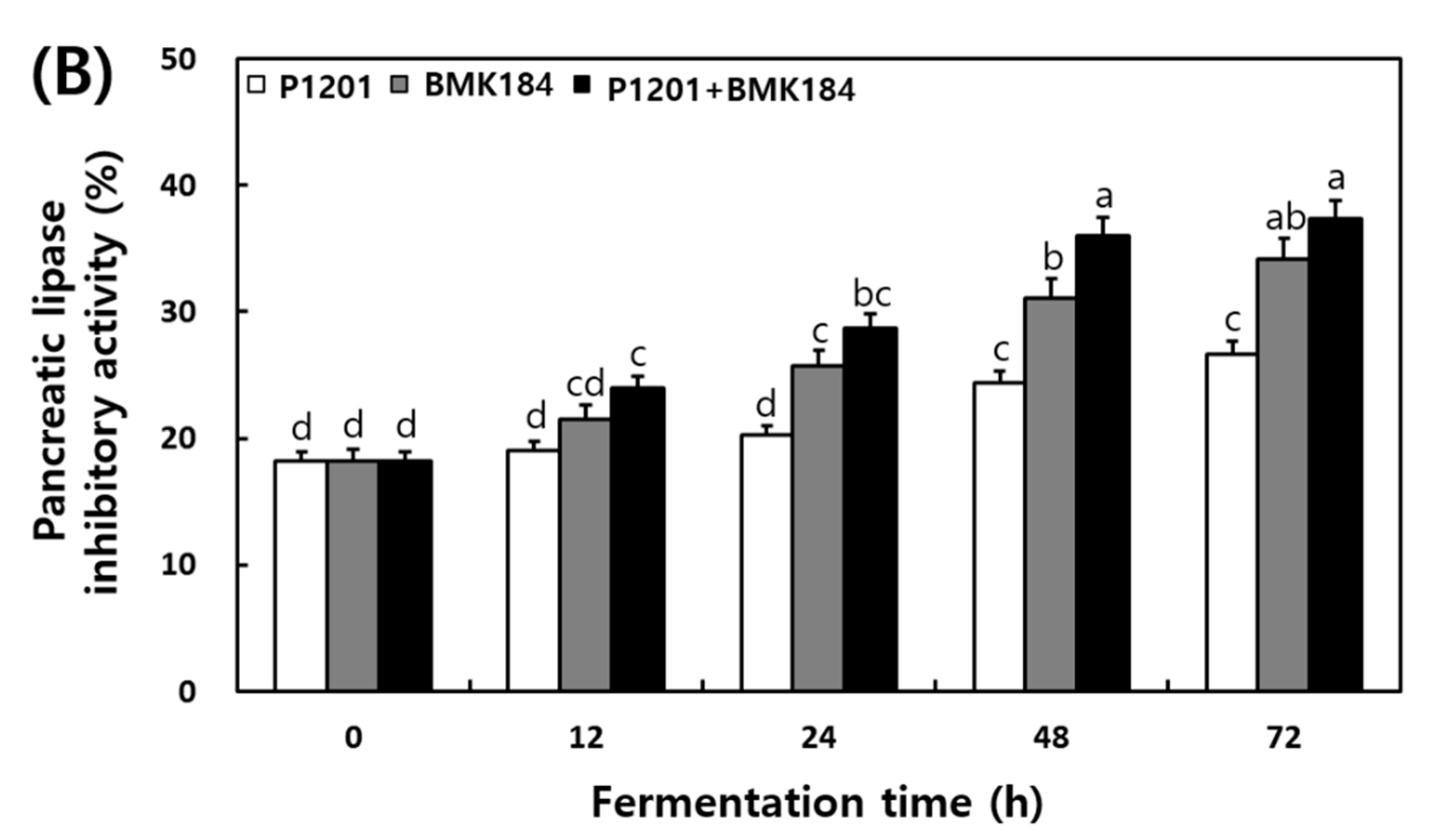
| Starter/Index 1 | Fermentation Times 2 (h) | ||||
|---|---|---|---|---|---|
| 0 | 12 | 24 | 48 | 72 | |
| Lactiplantibacillus plantarum P1201 | |||||
| pH | 6.19 ± 0.37 a | 6.14 ±0.37 a | 6.05 ± 0.36 a | 4.07 ± 0.24 c | 3.97 ± 0.24 c |
| Acidity (%, as lactic acid) | 0.32 ± 0.02 c | 0.36 ± 0.02 c | 0.41 ± 0.02 c | 1.05 ± 0.06 b | 1.89 ± 0.11 a |
| Viable cell numbers (log cfu/g) | 6.48 ± 0.39 e | 7.01 ± 0.36 de | 8.38 ± 0.50 c | 10.98 ± 0.60 a | 9.61 ± 0.64 b |
| Glutamate decarboxylase activity (unit/g) | <0.01 | <0.01 | <0.01 | <0.01 | <0.01 |
| β-glucosidase activity (unit/g) | 0.08 ± 0.00 d | 0.52 ± 0.01 c | 1.77 ± 0.02 b | 2.43 ± 0.02 a | 2.04 ± 0.01 ab |
| Levilactobacillus brevis BMK184 | |||||
| pH | 6.19 ± 0.37 a | 5.47 ± 0.33 b | 5.41 ± 0.32 b | 5.40 ± 0.32 b | 5.39 ± 0.32 b |
| Acidity (%, as lactic acid) | 0.32 ± 0.02 c | 0.58 ± 0.03 bc | 0.61 ± 0.04 bc | 0.73 ± 0.04 b | 0.93 ± 0.06 b |
| Viable cell numbers (log cfu/g) | 6.60 ± 0.40 e | 7.45 ± 0.57 d | 9.60 ± 0.58 b | 9.86 ± 0.59 b | 9.69 ± 0.58 b |
| Glutamate decarboxylase activity (unit/g) | 0.12 ± 0.00 e | 0.86 ± 0.01 d | 2.94 ± 0.04 c | 4.43 ± 0.05 a | 3.87 ± 0.03 b |
| β-glucosidase activity (unit/g) | 0.11 ± 0.00 d | 0.62 ± 0.01 c | 1.81 ± 0.02 b | 2.54 ± 0.02 a | 2.30 ± 0.02 a |
| Lactiplantibacillus plantarum P1201 + Levilactobacillus brevis BMK184 | |||||
| pH | 6.14 ± 0.37 a | 5.49 ± 0.33 b | 5.22 ± 0.31 b | 4.47 ± 0.27 bc | 4.19 ± 0.25 c |
| Acidity (%, as lactic acid) | 0.33 ± 0.02 c | 0.61 ± 0.04 bc | 0.91 ± 0.05 b | 1.35 ± 0.08 ab | 1.80 ± 0.11 a |
| Viable cell numbers (log cfu/g) | 6.35 ± 0.38 e | 7.41 ± 0.56 d | 9.50 ± 0.57 b | 10.65 ± 0.64 a | 9.71 ± 0.58 b |
| Glutamate decarboxylase activity (unit/g) | 0.13 ± 0.00 e | 0.79 ± 0.01 d | 2.82 ± 0.03 c | 4.13 ± 0.05 a | 3.72 ± 0.03 b |
| β-glucosidase activity (unit/g) | 0.11 ± 0.00 d | 0.65 ± 0.01 c | 1.94 ± 0.02 b | 2.66 ± 0.03 a | 2.42 ± 0.02 a |
| Starter/Contents 1 (mg/100 g) | Fermentation Times 2 (h) | ||||
|---|---|---|---|---|---|
| 0 | 12 | 24 | 48 | 72 | |
| Lactiplantibacillus plantarumP1201 | |||||
| Glutamic acid | 52.25 ± 0.31 a | 45.13 ± 0.33 b | 46.22 ± 0.34 b | 45.72 ± 0.33 b | 41.37 ± 0.27 b |
| γ-aminobutyric acid | 131.69 ± 0.79 e | 144.94 ± 8.81 d | 147.17 ± 8.82 cd | 144.15 ± 8.80 d | 141.83 ± 8.79 d |
| Levilactobacillus brevisBMK184 | |||||
| Glutamic acid | 44.51 ± 2.67 b | 44.52 ± 0.27 b | 32.35 ± 0.24 c | 16.85 ± 0.11 d | 18.26 ± 0.11 d |
| γ-aminobutyric acid | 141.63 ± 8.50 d | 149.61 ± 8.98 cd | 162.23 ± 9.73 b | 169.81 ± 10.19 ab | 173.09 ± 10.39 a |
| Lactiplantibacillus plantarumP1201 + Levilactobacillus brevis BMK184 | |||||
| Glutamic acid | 43.68 ± 0.26 b | 45.76 ± 0.27 b | 39.40 ± 0.24 c | 13.35 ± 0.08 e | 11.25 ± 0.07 e |
| γ-aminobutyric acid | 144.24 ± 8.87 d | 144.43 ± 8.81 d | 153.44 ± 0.92 c | 165.48 ± 9.99 b | 175.59 ± 10.05 a |
| Starter/Contents (mg/g) 1 | Fermentation Times 2 (h) | ||||
|---|---|---|---|---|---|
| 0 | 12 | 24 | 48 | 72 | |
| Lactiplantibacillus plantarum P1201 | |||||
| Total phenolic contents | 9.55 ± 0.22 c | 9.80 ± 0.20 c | 10.01 ± 0.40 bc | 10.54 ± 0.21 b | 10.71 ± 0.43 b |
| Total flavonoid contents | 15.04 ± 0.36 d | 15.55 ± 0.47 d | 17.03 ± 0.51 c | 17.23 ± 0.52 c | 18.74 ± 0.19 b |
| Levilactobacillus brevis BMK184 | |||||
| Total phenolic contents | 9.68 ± 0.24 c | 9.89 ± 0.40 c | 10.32 ± 0.41 b | 10.74 ± 0.43 b | 11.38 ± 0.23 a |
| Total flavonoid contents | 15.45 ± 0.31 d | 16.11 ± 0.26 cd | 17.96 ± 0.54 c | 18.81 ± 0.38 b | 19.33 ± 0.58 b |
| Lactiplantibacillus plantarum P1201+ Levilactobacillus brevis BMK184 | |||||
| Total phenolic contents | 9.70 ± 0.26 c | 10.18 ± 0.31 bc | 10.55 ± 0.42 b | 11.88 ± 0.48 a | 11.90 ± 0.48 a |
| Total flavonoid contents | 16.02 ± 0.35 cd | 17.31 ± 0.69 c | 19.69 ± 0.39 b | 20.61 ± 0.41 a | 21.48 ± 0.21 a |
| Starter/Contents (μg/g) 1 | Fermentation Times 2 (h) | ||||
|---|---|---|---|---|---|
| 0 | 12 | 24 | 48 | 72 | |
| Lactiplantibacillus plantarum P1201 | |||||
| Daidzin | 4276.31 ± 256.85 ab | 4577.09 ± 274.63 a | 4434.50 ± 266.07 a | 4485.15 ± 269.11 a | 3199.04 ± 191.94 bc |
| Genistin | 2361.20 ± 141.67 a | 2515.72 ± 150.94 a | 2471.22 ± 148.27 a | 2505.79 ± 150.35 a | 2189.00 ± 131.34 ab |
| Malonyldaidzin | 395.13 ± 23.71 ab | 420.12 ± 25.21 a | 390.55 ± 23.43 ab | 400.64 ± 24.04 a | 379.87 ± 22.79 ab |
| Malonylgenistin | 606.37 ± 36.38 a | 625.37 ± 37.52 a | 599.57 ± 35.97 a | 602.91 ± 36.17 a | 440.54 ± 26.43 c |
| Daidzein | 754.11 ± 45.25 e | 649.97 ± 39.00 f | 616.03 ± 36.96 f | 617.49 ± 37.05 f | 1460.02 ± 87.60 cd |
| Genistein | 240.38 ± 14.42 ef | 202.40 ± 12.14 e | 184.85 ± 11.09 e | 185.19 ± 11.11 e | 316.55 ± 18.99 f |
| Total | 8633.49 | 8990.67 | 8696.72 | 8797.18 | 7985.02 |
| Levilactobacillus brevis BMK184 | |||||
| Daidzin | 4225.26 ± 253.51 ab | 3413.37 ± 204.80 b | 3519.23 ± 211.15 b | 2919.84 ± 175.19 bc | 2717.60 ± 163.06 c |
| Genistin | 2400.95 ± 144.06 a | 1926.56 ± 115.59 b | 1805.54 ± 108.33 b | 1338.08 ± 80.28 c | 910.85 ± 54.65 d |
| Malonyldaidzin | 408.01 ± 24.48 a | 370.22 ± 22.21 b | 384.06 ± 23.04 ab | 358.33 ± 21.50 b | 364.75 ± 21.89 b |
| Malonylgenistin | 587.37 ± 35.24 ab | 474.82 ± 28.49 bc | 495.65 ± 29.74 b | 460.06 ± 27.60 bc | 451.10 ± 27.07 c |
| Daidzein | 747.54 ± 44.85 e | 1233.61 ± 74.02 d | 1312.07 ± 78.72 d | 1669.57 ± 100.17 c | 2008.11 ± 120.49 b |
| Genistein | 236.93 ± 14.22 ef | 471.29 ± 28.28 d | 619.11 ± 37.15 c | 826.72 ± 49.60 b | 1055.27 ± 63.32 a |
| Total | 8606.07 | 7889.87 | 8135.65 | 7572.61 | 7507.68 |
| Lactiplantibacillus plantarum P1201+ Levilactobacillus brevis BMK184 | |||||
| Daidzin | 4327.03 ± 259.62 a | 3931.18 ± 235.87 ab | 3745.84 ± 224.75 b | 2535.66 ± 152.14 c | 3082.27 ± 184.94 bc |
| Genistin | 2459.23 ± 147.55 a | 2144.18 ± 128.65 ab | 1925.64 ± 115.54 b | 1204.33 ± 72.26 c | 1211.84 ± 72.71 c |
| Malonyldaidzin | 417.63 ± 25.06 a | 339.14 ± 20.35 b | 378.64 ± 22.72 ab | 284.51 ± 17.07 c | 290.68 ± 17.44 c |
| Malonylgenistin | 609.59 ± 36.58 a | 527.53 ± 31.65 b | 604.93 ± 36.30 a | 471.10 ± 28.27 bc | 418.69 ± 25.12 c |
| Daidzein | 749.27 ± 44.96 e | 1035.28 ± 62.12 de | 1164.63 ± 69.88 de | 1939.64 ± 116.38 b | 2265.57 ± 135.93 a |
| Genistein | 217.93 ± 13.08 e | 342.38 ± 20.54 f | 551.18 ± 33.07 cd | 963.49 ± 57.81 a | 987.65 ± 59.26 a |
| Total | 8780.68 | 8319.70 | 8370.87 | 7906.62 | 7748.83 |
Publisher’s Note: MDPI stays neutral with regard to jurisdictional claims in published maps and institutional affiliations. |
© 2022 by the authors. Licensee MDPI, Basel, Switzerland. This article is an open access article distributed under the terms and conditions of the Creative Commons Attribution (CC BY) license (https://creativecommons.org/licenses/by/4.0/).
Share and Cite
Lee, H.Y.; Cho, D.Y.; Jang, K.J.; Lee, J.H.; Jung, J.G.; Kim, M.J.; Jeong, J.B.; Haque, M.A.; Cho, K.M. Changes of γ-Aminobutyric Acid, Phytoestrogens, and Biofunctional Properties of the Isoflavone-Enriched Soybean (Glycine max) Leaves during Solid Lactic Acid Fermentation. Fermentation 2022, 8, 525. https://doi.org/10.3390/fermentation8100525
Lee HY, Cho DY, Jang KJ, Lee JH, Jung JG, Kim MJ, Jeong JB, Haque MA, Cho KM. Changes of γ-Aminobutyric Acid, Phytoestrogens, and Biofunctional Properties of the Isoflavone-Enriched Soybean (Glycine max) Leaves during Solid Lactic Acid Fermentation. Fermentation. 2022; 8(10):525. https://doi.org/10.3390/fermentation8100525
Chicago/Turabian StyleLee, Hee Yul, Du Yong Cho, Kyeong Jin Jang, Jin Hwan Lee, Jea Gack Jung, Min Ju Kim, Jong Bin Jeong, Md. Azizul Haque, and Kye Man Cho. 2022. "Changes of γ-Aminobutyric Acid, Phytoestrogens, and Biofunctional Properties of the Isoflavone-Enriched Soybean (Glycine max) Leaves during Solid Lactic Acid Fermentation" Fermentation 8, no. 10: 525. https://doi.org/10.3390/fermentation8100525
APA StyleLee, H. Y., Cho, D. Y., Jang, K. J., Lee, J. H., Jung, J. G., Kim, M. J., Jeong, J. B., Haque, M. A., & Cho, K. M. (2022). Changes of γ-Aminobutyric Acid, Phytoestrogens, and Biofunctional Properties of the Isoflavone-Enriched Soybean (Glycine max) Leaves during Solid Lactic Acid Fermentation. Fermentation, 8(10), 525. https://doi.org/10.3390/fermentation8100525





